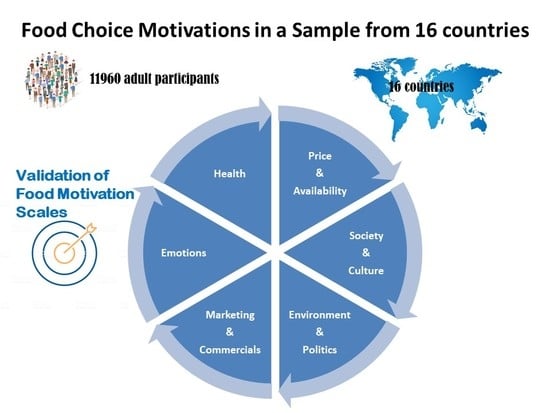Study about Food Choice Determinants According to Six Types of Conditioning Motivations in a Sample of 11,960 Participants
Abstract
1. Introduction
2. Materials and Methods
2.1. Questionnaire
2.2. Data Collection
2.3. Analysis of the Data
- (a)
- Values used for absolute fit: Ratio of chi-square and degrees of freedom (χ2/df)—if (χ2/df) is equal to 1 the fit is perfect, for values lower than 2 it is good, for values lower than 5 it is acceptable and for values greater than 5 is unacceptable. Root mean square residual (RMR)—the lower the value of RMR the better is the fit, so RMR = 0 indicates a perfect fit. Standardized root mean square residual (SRMR)—a value of zero indicates a perfect fit and values lower than 0.08 are generally considered a good fit. Goodness of fit index (GFI)—values around 0.95 or higher are recommended (with maximum value equal to 1), but values over 0.90 are considered a good fit.
- (b)
- Values for relative fit: Comparative fit index (CFI), which is an additional comparative index of the adjustment to the model—values lower than 0.90 indicate a poor fit, values between 0.90 and 0.95 indicate a good adjustment and above 0.95 a very good adjustment (maximum value of 1 corresponds to perfect fit). This index is independent of the sample size.
- (c)
- Population discrepancy index: Root mean square error of approximation (RMSEA)—reference values for the RMSEA, with a 90% confidence interval, between 0.05 and 0.08 mean the adjustment is good, while it is considered very good when the index is lower than 0.05.
3. Results
3.1. Health Motivations
3.2. Emotional Motivations
3.3. Economic and Availability Motivations
3.4. Social and Cultural Motivations
3.5. Environmental and Political Motivations
3.6. Marketing and Commercials Motivations
4. Discussion
5. Conclusions
Author Contributions
Funding
Acknowledgments
Conflicts of Interest
Appendix A
| Section 1—Health motivations: |
| Q1.1. I am very concerned about the hygiene and safety of the food I eat; |
| Q1.2. It is important for me that my diet is low in fat; |
| Q1.3. Usually I follow a healthy and balanced diet; |
| Q1.4. It is important for me that my daily diet contains a lot of vitamins and minerals; |
| Q1.5. There are some foods that I consume regularly, even if they may raise my cholesterol; |
| Q1.6. I try to eat foods that do not contain additives; |
| Q1.7. I avoid eating processed foods, because of their lower nutritional quality; |
| Q1.8. It is important for me to eat food that keeps me healthy; |
| Q1.9. There are some foods that I consume regularly, even if they may raise my blood glycaemia; |
| Q1.10. I avoid foods with genetically modified organisms; |
| Section 2—Emotional motivations: |
| Q2.1. Food helps me cope with stress; |
| Q2.2. I usually eat food that helps me control my weight; |
| Q2.3. I often consume foods that keep me awake and alert (such as coffee, coke, energy drinks); |
| Q2.4. I often consume foods that help me relax (such as some teas, red wine); |
| Q2.5. Food makes me feel good; |
| Q2.6. When I feel lonely, I console myself by eating; |
| Q2.7. I eat more when I have nothing to do; |
| Q2.8. For me, food serves as an emotional consolation; |
| Q2.9. I have more cravings for sweets when I am depressed; |
| Section 3—Economic and Availability motivations: |
| Q3.1. I usually choose food that has a good quality/price ratio; |
| Q3.2. The main reason for choosing a food is its low price; |
| Q3.3. I choose the food I consume, because it is convenient to purchase; |
| Q3.4. I buy fresh vegetables to cook myself more often than frozen; |
| Q3.5. I usually buy food that is easy to prepare; |
| Q3.6. I usually buy food that it is on sale; |
| Q3.7. I prefer to buy food that is ready to eat or pre-cooked; |
| Section 4—Social and Cultural motivations: |
| Q4.1. Meals are a time of fellowship and pleasure; |
| Q4.2. I eat more than usual when I have company; |
| Q4.3. It is important to me that the food I eat is similar to the food I ate when I was a child; |
| Q4.4. I eat certain foods because other people (my colleagues, friends, family) also eat it; |
| Q4.5. I prefer to eat alone; |
| Q4.6. I choose the foods I eat, because it fits the season; |
| Q4.7. I eat certain foods because I am expected to eat them; |
| Q4.8. I like to try new foods to which I am not accustomed; |
| Q4.9. I usually eat food that is trendy; |
| Section 5—Environmental & Political motivations: |
| Q5.1. It is important to me that the food I eat is prepared/packed in an environmentally friendly way; |
| Q5.2. When I cook I have in mind the quantities to avoid food waste; |
| Q5.3. It is important to me that the food I eat comes from my own country; |
| Q5.4. I prefer to eat food that has been produced in a way that animals’ rights have been respected; |
| Q5.5. I choose foods that have been produced in countries where human rights are not violated; |
| Q5.6. I avoid going to restaurants that do not have a recovery policy of food surplus; |
| Q5.7. I prefer to buy foods that comply with policies of minimal usage of packaging; |
| Section 6—Marketing and Commercials motivations: |
| Q6.1. When I buy food I usually do not care about the marketing campaigns happening in the shop; |
| Q6.2. I eat what I eat, because I recognize it from advertisements or have seen it on TV; |
| Q6.3. I usually buy food that spontaneously appeals to me (e.g., situated at eye level, appealing colors, pleasant packaging); |
| Q6.4. When I go shopping I prefer to read food labels instead of believing in advertising campaigns; |
| Q6.5. Food advertising campaigns increase my desire to eat certain foods; |
| Q6.6. Brands are important to me when making food choices; |
| Q6.7. I try to schedule my shopping for when I know there are promotions or discounts. |
References
- Cabral, D.; Cunha, L.M.; Vaz de Almeida, M.D. Food choice and food consumption frequency of Cape Verde inhabitants. Appetite 2019, 139, 26–34. [Google Scholar] [CrossRef] [PubMed]
- McGuire, S. Scientific Report of the 2015 Dietary Guidelines Advisory Committee. Washington, DC: US Departments of Agriculture and Health and Human Services, 2015. Adv. Nutr. 2016, 7, 202–204. [Google Scholar] [CrossRef] [PubMed]
- Keegan, E.; Kemps, E.; Prichard, I.; Polivy, J.; Herman, C.P.; Tiggemann, M. The effect of the spatial positioning of a healthy food cue on food choice from a pictorial-style menu. Eat. Behav. 2019, 34, 101313. [Google Scholar] [CrossRef] [PubMed]
- Hu, X.F.; Kenny, T.-A.; Chan, H.M. Inuit Country Food Diet Pattern Is Associated with Lower Risk of Coronary Heart Disease. J. Acad. Nutr. Diet. 2018, 118, 1237.e1–1248.e1. [Google Scholar] [CrossRef]
- Iwatani, S.; Yamamoto, N. Functional food products in Japan: A review. Food Sci. Hum. Wellness 2019, 8, 96–101. [Google Scholar] [CrossRef]
- Novak Nicole, L.; Brownell Kelly, D. Role of Policy and Government in the Obesity Epidemic. Circulation 2012, 126, 2345–2352. [Google Scholar] [CrossRef]
- Novak, N.L.; Brownell, K.D. Obesity: A public health approach. Psychiatr. Clin. N. Am. 2011, 34, 895–909. [Google Scholar] [CrossRef]
- Sares-Jäske, L.; Knekt, P.; Lundqvist, A.; Heliövaara, M.; Männistö, S. Dieting attempts modify the association between quality of diet and obesity. Nutr. Res. 2017, 45, 63–72. [Google Scholar] [CrossRef]
- Deroost, N.; Cserjési, R. Attentional avoidance of emotional information in emotional eating. Psychiatr. Res. 2018, 269, 172–177. [Google Scholar] [CrossRef]
- Van den Tol, A.J.M.; Ward, M.R.; Fong, H. The role of coping in emotional eating and the use of music for discharge when feeling stressed. Arts Psychother. 2019, 64, 95–103. [Google Scholar] [CrossRef]
- Bartolini, F. Food Trade and Global Value Chain. In Encyclopedia of Food Security and Sustainability; Ferranti, P., Berry, E.M., Anderson, J.R., Eds.; Elsevier: Oxford, UK, 2019; pp. 82–87. ISBN 978-0-12-812688-2. [Google Scholar]
- Asian, S.; Hafezalkotob, A.; John, J.J. Sharing economy in organic food supply chains: A pathway to sustainable development. Int. J. Prod. Econ. 2019, 218, 322–338. [Google Scholar] [CrossRef]
- Steg, L.; Vlek, C. Encouraging pro-environmental behaviour: An integrative review and research agenda. J. Environ. Psychol. 2009, 29, 309–317. [Google Scholar] [CrossRef]
- Taghikhah, F.; Voinov, A.; Shukla, N. Extending the supply chain to address sustainability. J. Clean. Prod. 2019, 229, 652–666. [Google Scholar] [CrossRef]
- Wann, D.L. Preliminary Validation of the Sport Fan Motivation Scale. J. Sport Soc. Issues 2016. [Google Scholar] [CrossRef]
- Kim, Y.G.; Eves, A. Construction and validation of a scale to measure tourist motivation to consume local food. Tour. Manag. 2012, 33, 1458–1467. [Google Scholar] [CrossRef]
- Guiné, R.; Duarte, J.; Ferreira, M.; Correia, P.; Leal, M.; Rumbak, I.; Baric, I.; Komes, D.; Satalic, Z.; Saric, M.; et al. Knowledge about dietary fibres (KADF): Development and validation of an evaluation instrument through structural equation modelling (SEM). Public Health 2016, 138, 108–118. [Google Scholar] [CrossRef]
- Ferrão, A.C.; Guine, R.P.F.; Correia, P.M.R.; Ferreira, M.; Duarte, J.; Lima, J. Development of A Questionnaire To Assess People’s Food Choices Determinants. Curr. Nutr. Food Sci. 2019, 15, 281–295. [Google Scholar] [CrossRef]
- Marôco, J. Análise Estatística com o SPSS Statistics, 7th ed.; ReportNumber: Lisbon, Portugal, 2018. [Google Scholar]
- Broen, M.P.G.; Moonen, A.J.H.; Kuijf, M.L.; Dujardin, K.; Marsh, L.; Richard, I.H.; Starkstein, S.E.; Martinez–Martin, P.; Leentjens, A.F.G. Factor analysis of the Hamilton Depression Rating Scale in Parkinson’s disease. Parkinsonism Relat. Disord. 2015, 21, 142–146. [Google Scholar] [CrossRef]
- Costa, M.G.F.A.; Neves, M.M.J.C.; Duarte, J.C.; Pereira, A.M.S. Conhecimento dos pais sobre alimentação: Construção e validação de um questionário de alimentação infantil. Rev. Enferm. Ref. 2012, 6, 55–68. [Google Scholar] [CrossRef]
- Tanaka, K.; Akechi, T.; Okuyama, T.; Nishiwaki, Y.; Uchitomi, Y. Development and validation of the Cancer Dyspnoea Scale: A multidimensional, brief, self-rating scale. Br. J. Cancer 2000, 82, 800–805. [Google Scholar] [CrossRef]
- Harrington, D. Confirmatory Factor Analysis; Oxford University Press: New York, NY, USA, 2009. [Google Scholar]
- Brown, T.A. Confirmatory Factor Analysis for Applied Research, 2nd ed.; Guilford Press: New York, NY, USA, 2015. [Google Scholar]
- Hair, J.F.; Black, W.C.; Babin, B.J.; Anderson, R.E. Multivariate Data Analysis, 7 ed.; Prentice Hall: Upper Saddle River, NJ, USA, 2009; ISBN 978-0-13-813263-7. [Google Scholar]
- Marôco, J. Análise de Equações Estruturais. Fundamentos teóricos, Software e Aplicações; ReportNumber: Lisboa, Portugal, 2014. [Google Scholar]
- Sidali, K.L.; Pizzo, S.; Garrido-Pérez, E.I.; Schamel, G. Between food delicacies and food taboos: A structural equation model to assess Western students’ acceptance of Amazonian insect food. Food Res. Int. 2019, 115, 83–89. [Google Scholar] [CrossRef] [PubMed]
- Lagerkvist, C.J.; Amuakwa-Mensah, F.; Tei Mensah, J. How consumer confidence in food safety practices along the food supply chain determines food handling practices: Evidence from Ghana. Food Control 2018, 93, 265–273. [Google Scholar] [CrossRef]
- Lim, T.-P.; Chye, F.-Y.; Sulaiman, M.R.; Suki, N.M.; Lee, J.-S. A Structural Modeling on Food Safety Knowledge, Attitude, and Behaviour Among Bum Bum Island community of Semporna, Sabah. Food Control 2015. [Google Scholar] [CrossRef]
- Ting, H.; Fam, K.-S.; Jun Hwa, J.C.; Richard, J.E.; Xing, N. Ethnic food consumption intention at the touring destination: The national and regional perspectives using multi-group analysis. Tourism Manag. 2019, 71, 518–529. [Google Scholar] [CrossRef]
- Schäfer, F.; Jeanne, J.-F. Evaluating the effects of food on health in a world of evolving operational challenges. Contemp. Clin. Trials Commun. 2018, 12, 51–54. [Google Scholar] [CrossRef] [PubMed]
- Adewumi, G.A. Health-Promoting Fermented Foods. In Encyclopedia of Food Chemistry; Melton, L., Shahidi, F., Varelis, P., Eds.; Academic Press: Oxford, UK, 2019; pp. 399–418. ISBN 978-0-12-814045-1. [Google Scholar]
- Shang, N.; Chaplot, S.; Wu, J. 12-Food proteins for health and nutrition. In Proteins in Food Processing, 2nd ed.; Yada, R.Y., Ed.; Woodhead Publishing Series in Food Science, Technology and Nutrition; Woodhead Publishing: Cambridge, UK, 2018; pp. 301–336. ISBN 978-0-08-100722-8. [Google Scholar]
- Akinmoladun, A.C.; Farombi, T.H.; Farombi, E.O. Food for Brain Health: Flavonoids. In Encyclopedia of Food Chemistry; Melton, L., Shahidi, F., Varelis, P., Eds.; Academic Press: Oxford, UK, 2019; pp. 370–386. ISBN 978-0-12-814045-1. [Google Scholar]
- Lucan, S.C. When food isn’t medicine—A challenge for physicians and health systems. Prev. Med. Rep. 2018, 10, 62–65. [Google Scholar] [CrossRef] [PubMed]
- Behrens, J.; Montes, N.; Silva, M. Effect of nutrition and health claims on the acceptability of soymilk beverages. Int. J. Food Sci. Technol. 2007, 42, 50–56. [Google Scholar] [CrossRef]
- Musto, M.; Cardinale, D.; Lucia, P.; Faraone, D. Creating Public Awareness of How Goats Are Reared and Milk Produced May Affect Consumer Acceptability. J. Appl. Anim.Welf. Sci. 2016, 19, 217–233. [Google Scholar] [CrossRef]
- Mantau, A.; Hattula, S.; Bornemann, T. Individual determinants of emotional eating: A simultaneous investigation. Appetite 2018, 130, 93–103. [Google Scholar] [CrossRef]
- Samuel, L.; Cohen, M. Expressive suppression and emotional eating in older and younger adults: An exploratory study. Arch. Gerontol. Geriatr. 2018, 78, 127–131. [Google Scholar] [CrossRef]
- Scholliers, P. Convenience foods. What, why, and when. Appetite 2015, 94, 2–6. [Google Scholar] [CrossRef] [PubMed]
- Verriet, J. Ready meals and cultural values in the Netherlands, 1950–1970. Food Hist. 2013, 11, 123–153. [Google Scholar] [CrossRef]
- Sheely, M. Global adoption of convenience foods. Am. J. Agric. Econ. 2008, 90, 1356–1365. [Google Scholar] [CrossRef]
- Brunner, T.A.; Horst, K.; Siegrist, M. Convenience food products. Drivers for consumption. Appetite 2010, 55, 498–506. [Google Scholar] [CrossRef] [PubMed]
- Frez-Muñoz, L.; Steenbekkers, B.L.P.A.; Fogliano, V. The Choice of Canned Whole Peeled Tomatoes is Driven by Different Key Quality Attributes Perceived by Consumers Having Different Familiarity with the Product. J. Food Sci. 2016, 81, S2988–S2996. [Google Scholar] [CrossRef]
- Nakata, R.; Kawai, N. The “social” facilitation of eating without the presence of others: Self-reflection on eating makes food taste better and people eat more. Physiol. Behav. 2017, 179, 23–29. [Google Scholar] [CrossRef]
- Baumeister, R.F.; Leary, M.R. The Need to Belong: Desire for Interpersonal Attachments as a Fundamental Human Motivation. Psychol. Bull. 1995, 117, 497–529. [Google Scholar] [CrossRef]
- Sommer, W.; Stürmer, B.; Shmuilovich, O.; Martin-Loeches, M.; Schacht, A. How about Lunch? Consequences of the Meal Context on Cognition and Emotion. PLoS ONE 2013, 8, e70314. [Google Scholar] [CrossRef]
- Salvy, S.J.; Howard, M.; Read, M.; Mele, E. The presence of friends increases food intake in youth. Am. J. Clin. Nutr. 2009, 90, 282–287. [Google Scholar] [CrossRef]
- Azzurra, A.; Massimiliano, A.; Angela, M. Measuring sustainable food consumption: A case study on organic food. Sustain. Prod. Consum. 2019, 17, 95–107. [Google Scholar] [CrossRef]
- Verain, M.C.D.; Sijtsema, S.J.; Antonides, G. Consumer segmentation based on food-category attribute importance: The relation with healthiness and sustainability perceptions. Food Qual. Prefer. 2016, 48, 99–106. [Google Scholar] [CrossRef]
- Colliver, A. Sustainable Food Consumption: A Practice-Based ApproachElizabeth Sargant Wageningen Academic Publishers, Netherlands, 2014, 174 pp., ISBN 9789086862634. Aust. J. Environ. Educ. 2015, 31, 282–283. [Google Scholar] [CrossRef]
- Djekic, I.; Tomasevic, I. Environmental impacts of the meat chain – Current status and future perspectives. Trends Food Sci. Technol. 2016, 54, 94–102. [Google Scholar] [CrossRef]
- Grunert, K.G.; Hieke, S.; Wills, J. Sustainability labels on food products: Consumer motivation, understanding and use. Food Policy 2014, 44, 177–189. [Google Scholar] [CrossRef]
- Djekic, I.; Sanjuán, N.; Clemente, G.; Jambrak, A.R.; Djukić-Vuković, A.; Brodnjak, U.V.; Pop, E.; Thomopoulos, R.; Tonda, A. Review on environmental models in the food chain—Current status and future perspectives. J. Clean. Prod. 2018, 176, 1012–1025. [Google Scholar] [CrossRef]
- Bragg, M.A.; Roberto, C.A.; Harris, J.L.; Brownell, K.D.; Elbel, B. Marketing Food and Beverages to Youth Through Sports. J. Adolesc. Health 2018, 62, 5–13. [Google Scholar] [CrossRef]
- Cairns, G. Evolutions in food marketing, quantifying the impact, and policy implications. Appetite 2013, 62, 194–197. [Google Scholar] [CrossRef] [PubMed]
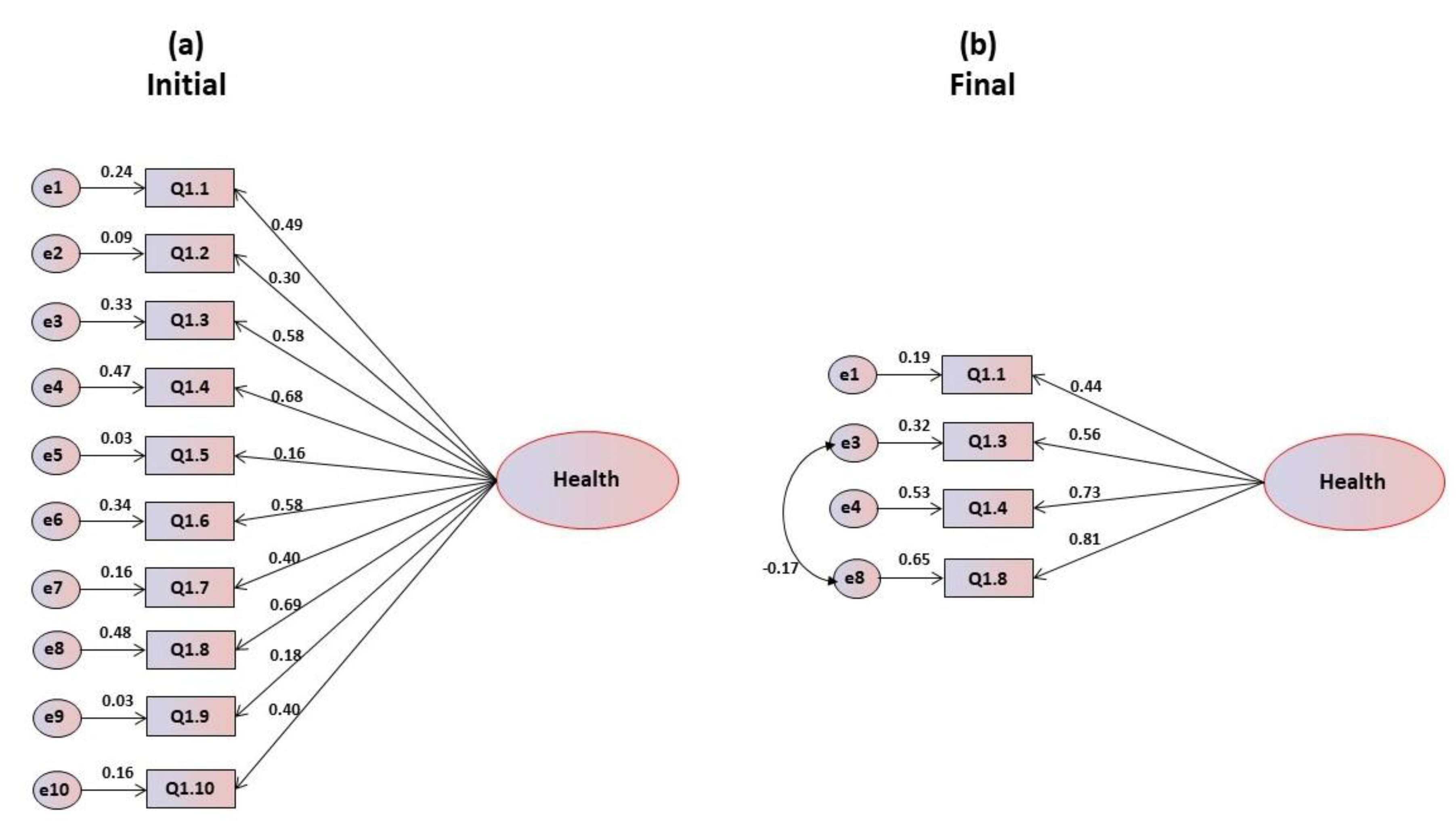
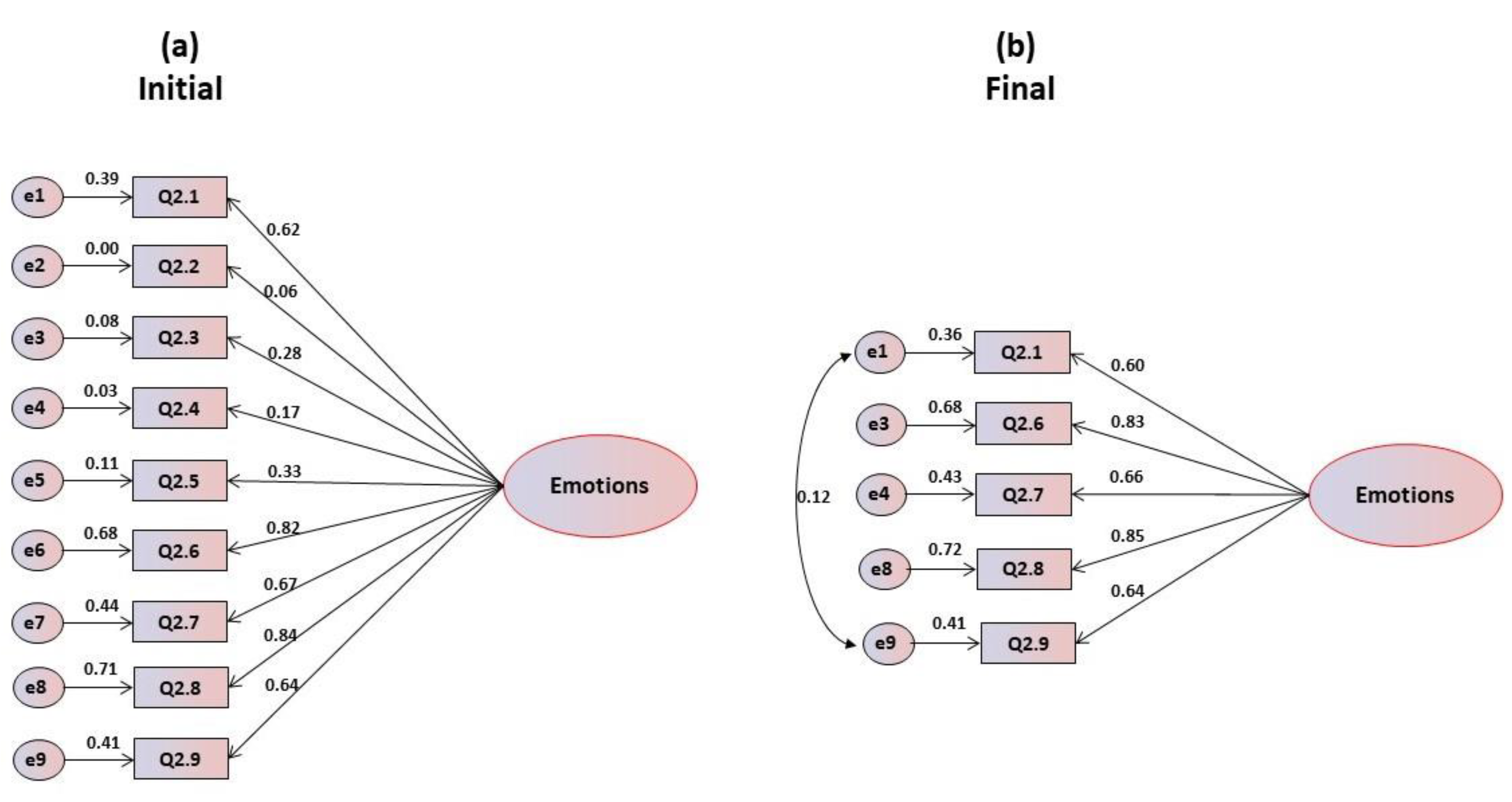
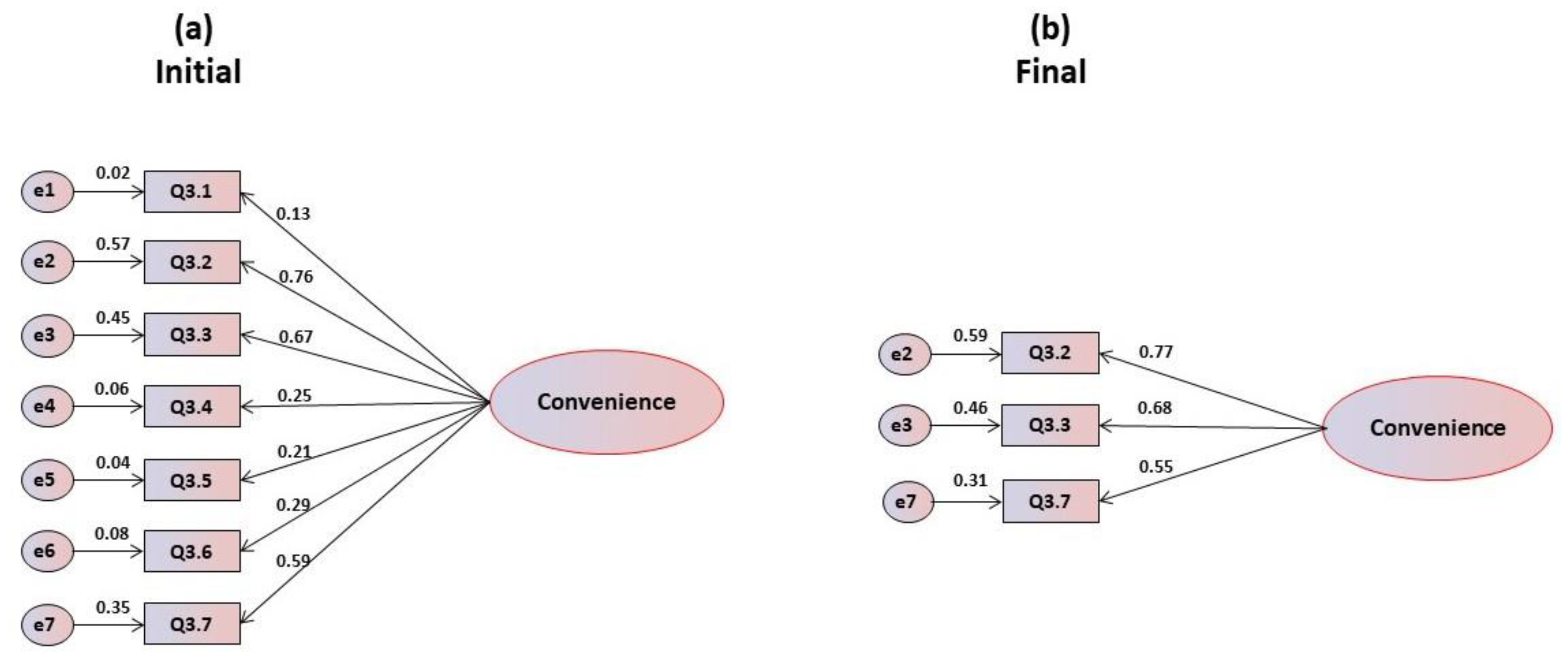
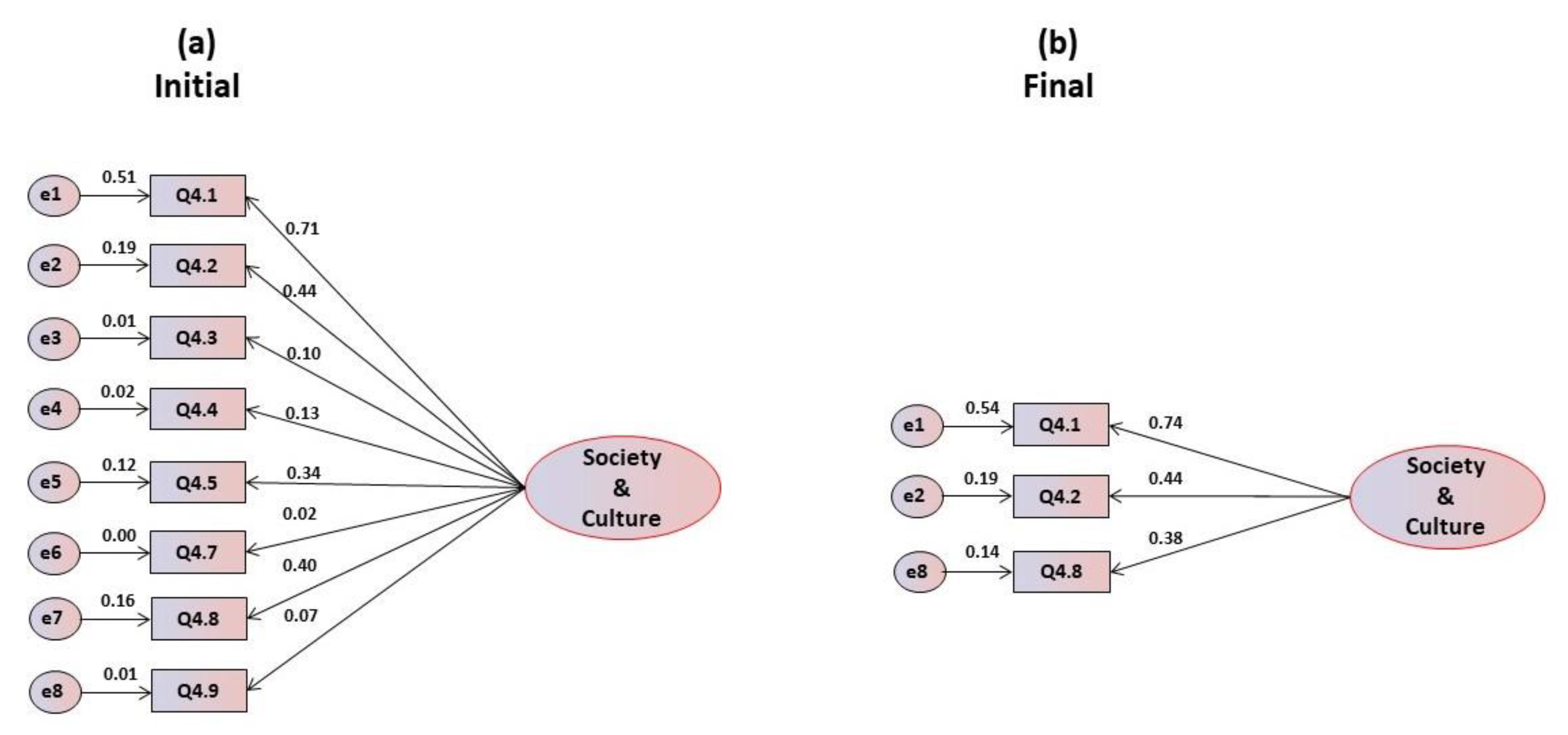
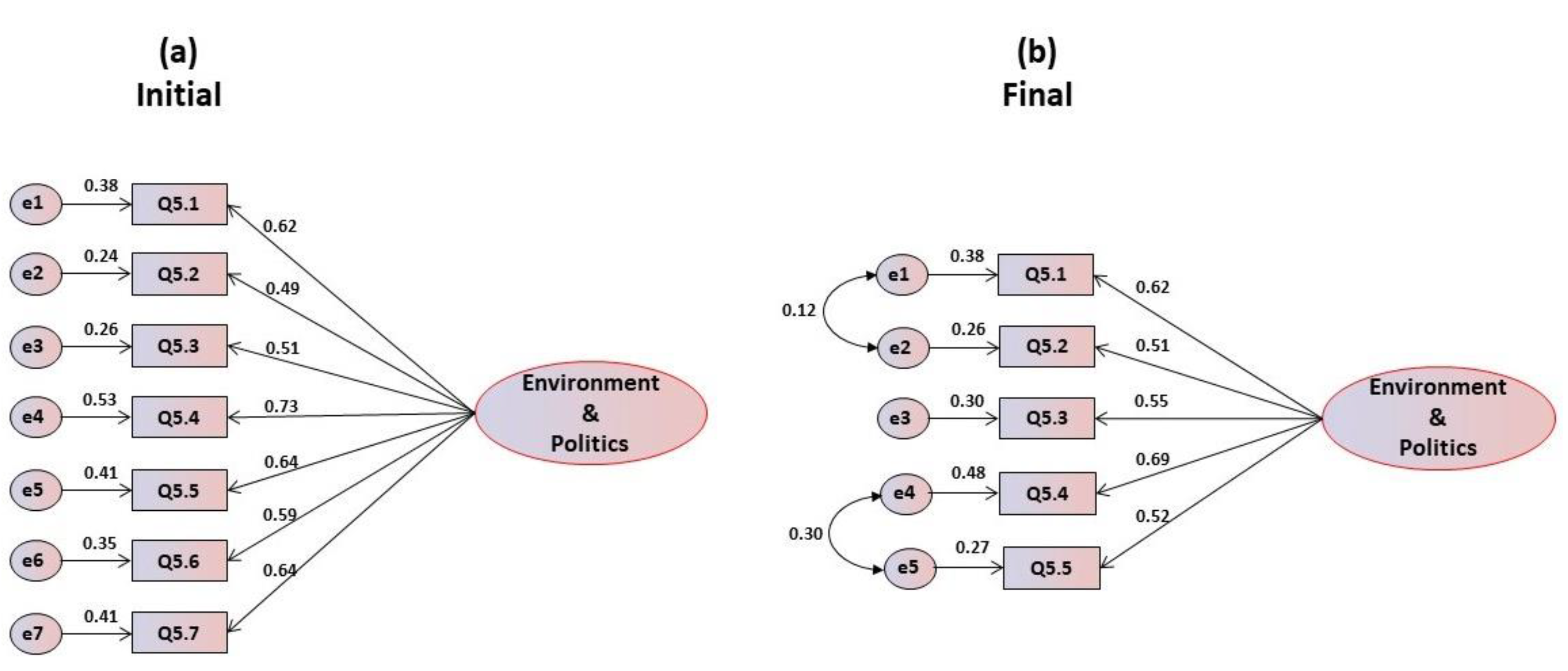
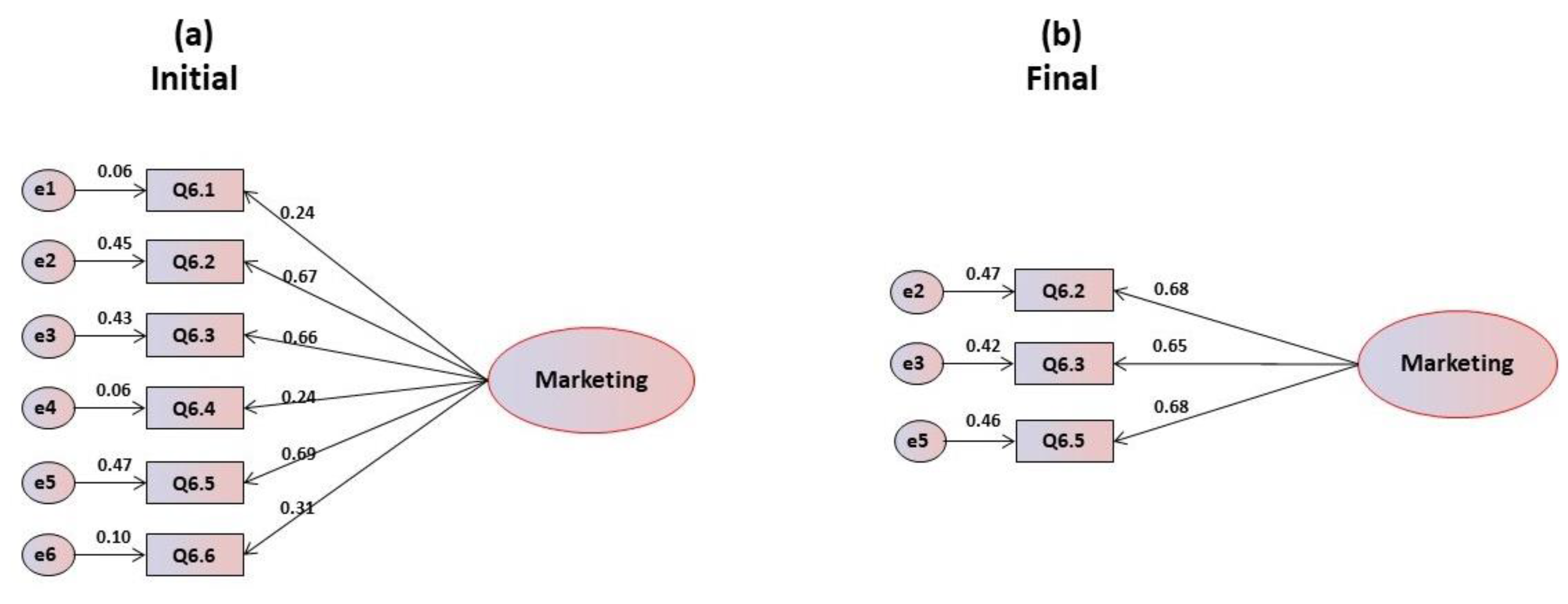
| Item | Internal Consistency of Items (Original) | ||||
|---|---|---|---|---|---|
| Mean Score | Standard Deviation | r (Item-Total) | r2 | α Without Item | |
| Q1.1 | 3.66 | 1.043 | 0.407 | 0.216 | 0.681 |
| Q1.2 | 3.21 | 1.073 | 0.264 | 0.127 | 0.705 |
| Q1.3 | 3.59 | 0.930 | 0.469 | 0.302 | 0.672 |
| Q1.4 | 3.74 | 0.931 | 0.489 | 0.408 | 0.669 |
| Q1.5 | 2.89 | 1.125 | 0.221 | 0.280 | 0.713 |
| Q1.6 | 3.38 | 1.017 | 0.509 | 0.359 | 0.663 |
| Q1.7 | 3.25 | 1.065 | 0.338 | 0.263 | 0.692 |
| Q1.8 | 3.95 | 0.949 | 0.507 | 0.412 | 0.666 |
| Q1.9 | 2.92 | 1.154 | 0.236 | 0.286 | 0.712 |
| Q1.10 | 3.24 | 1.147 | 0.329 | 0.176 | 0.695 |
| Global Cronbach’s alpha = 0.709 | |||||
| Fitting Indices of CFA Model 1 | Initial 2 | Final 3 | |||
| χ2/df | 228.0 | 6.921 | |||
| GFI | 0.883 | 1.000 | |||
| CFI | 0.668 | 0.999 | |||
| RMSEA | 0.138 | 0.022 | |||
| RMSR | 0.109 | 0.005 | |||
| SRMR | 0.090 | 0.054 | |||
| Item | Internal Consistency of Items (Original) | ||||
|---|---|---|---|---|---|
| Mean Score | Standard Deviation | r (Item-Total) | r2 | α Without Item | |
| Q2.1 | 2.98 | 1.123 | 0.569 | 0.359 | 0.708 |
| Q2.2 | 3.15 | 1.075 | 0.108 | 0.066 | 0.774 |
| Q2.3 | 2.82 | 1.282 | 0.290 | 0.103 | 0.754 |
| Q2.4 | 3.14 | 1.152 | 0.216 | 0.085 | 0.762 |
| Q2.5 | 3.49 | 1.100 | 0.332 | 0.219 | 0.744 |
| Q2.6 | 2.57 | 1.190 | 0.663 | 0.565 | 0.690 |
| Q2.7 | 2.98 | 1.250 | 0.553 | 0.415 | 0.708 |
| Q2.8 | 2.57 | 1.182 | 0.669 | 0.586 | 0.689 |
| Q2.9 | 2.94 | 1.265 | 0.507 | 0.400 | 0.716 |
| Global Cronbach’s alpha = 0.772 | |||||
| Fitting Indices of CFA Model 1 | Initial 2 | Final 3 | |||
| χ2/df | 105.0 | 0.610 | |||
| GFI | 0.951 | 1.000 | |||
| CFI | 0.901 | 1.000 | |||
| RMSEA | 0.093 | 0.000 | |||
| RMSR | 0.078 | 0.003 | |||
| SRMR | 0.058 | 0.017 | |||
| Item | Internal Consistency of Items (Original) | ||||
|---|---|---|---|---|---|
| Mean Score | Standard Deviation | r (Item-Total) | r2 | α Without Item | |
| Q3.1 | 3.62 | 1.010 | 0.121 | 0.246 | 0.508 |
| Q3.2 | 2.65 | 1.134 | 0.404 | 0.374 | 0.383 |
| Q3.3 | 3.04 | 1.123 | 0.372 | 0.309 | 0.399 |
| Q3.4 | 3.87 | 1.057 | -0.072 | 0.166 | 0.582 |
| Q3.5 | 3.17 | 1.091 | 0.327 | 0.155 | 0.422 |
| Q3.6 | 2.78 | 1.079 | 0.411 | 0.226 | 0.384 |
| Q3.7 | 2.41 | 1.188 | 0.164 | 0.342 | 0.497 |
| Global Cronbach’s alpha = 0.500 | |||||
| Fitting Indices of CFA Model 1 | Initial 2 | Final 3 | |||
| χ2/df | 404.1 | 0.000 | |||
| GFI | 0.867 | 1.000 | |||
| CFI | 0.606 | 1.000 | |||
| RMSEA | 0.184 | 0.000 | |||
| RMSR | 0.141 | 0.000 | |||
| SRMR | 0.124 | 0.000 | |||
| Item | Internal Consistency of Items (Original) | ||||
|---|---|---|---|---|---|
| Mean Score | Standard Deviation | r (Item-Total) | r2 | α Without Item | |
| Q4.1 | 3.74 | 1.034 | 0.178 | 0.219 | 0.487 |
| Q4.2 | 3.06 | 1.107 | 0.338 | 0.179 | 0.433 |
| Q4.3 | 2.65 | 1.072 | 0.273 | 0.133 | 0.457 |
| Q4.4 | 2.44 | 1.090 | 0.359 | 0.194 | 0.426 |
| Q4.5 | 2.61 | 1.131 | -0.004 | 0.164 | 0.548 |
| Q4.6 | 3.28 | 1.108 | 0.208 | 0.176 | 0.478 |
| Q4.7 | 2.62 | 1.199 | 0.260 | 0.167 | 0.459 |
| Q4.8 | 3.47 | 1.155 | 0.118 | 0.170 | 0.509 |
| Q4.9 | 2.38 | 1.080 | 0.281 | 0.235 | 0.454 |
| Global Cronbach’s alpha = 0.504 | |||||
| Fitting Indices of CFA Model 1 | Initial 2 | Final 3 | |||
| χ2/df | 321.7 | 0.000 | |||
| GFI | 0.854 | 1.000 | |||
| CFI | 0.348 | 1.000 | |||
| RMSEA | 0.164 | 0.000 | |||
| RMSR | 0.164 | 0.000 | |||
| SRMR | 0.132 | 0.000 | |||
| Item | Internal Consistency of Items (Original) | ||||
|---|---|---|---|---|---|
| Mean Score | Standard Deviation | r (Item-Total) | r2 | α Without Item | |
| Q5.1 | 3.48 | 0.996 | 0.554 | 0.326 | 0.769 |
| Q5.2 | 3.77 | 1.013 | 0.442 | 0.224 | 0.789 |
| Q5.3 | 3.30 | 1.089 | 0.459 | 0.218 | 0.787 |
| Q5.4 | 3.43 | 1.093 | 0.633 | 0.429 | 0.753 |
| Q5.5 | 3.06 | 1.045 | 0.542 | 0.357 | 0.771 |
| Q5.6 | 2.81 | 0.987 | 0.519 | 0.301 | 0.775 |
| Q5.7 | 3.20 | 1.021 | 0.565 | 0.338 | 0.767 |
| Global Cronbach’s alpha = 0.799 | |||||
| Fitting Indices of CFA Model 1 | Initial 2 | Final 3 | |||
| χ2/df | 93.44 | 0.987 | |||
| GFI | 0.969 | 1.000 | |||
| CFI | 0.937 | 1.000 | |||
| RMSEA | 0.088 | 0.000 | |||
| RMSR | 0.042 | 0.032 | |||
| SRMR | 0.039 | 0.026 | |||
| Item | Internal Consistency of Items (Original) | ||||
|---|---|---|---|---|---|
| Mean Score | Standard Deviation | r (Item-Total) | r2 | α Without Item | |
| Q6.1 | 3.18 | 1.113 | −0.049 | 0.121 | 0.498 |
| Q6.2 | 2.30 | 1.013 | 0.352 | 0.301 | 0.257 |
| Q6.3 | 2.67 | 1.130 | 0.274 | 0.290 | 0.299 |
| Q6.4 | 3.69 | 1.067 | −0.039 | 0.118 | 0.487 |
| Q6.5 | 2.71 | 1.118 | 0.329 | 0.314 | 0.261 |
| Q6.6 | 3.04 | 1.089 | 0.338 | 0.117 | 0.257 |
| Q6.7 | 3.00 | 1.071 | 0.324 | 0.105 | 0.310 |
| Global Cronbach’s alpha = 0.399 | |||||
| Fitting Indices of CFA Model 1 | Initial 2 | Final 3 | |||
| χ2/df | 163.8 | 0.000 | |||
| GFI | 0.958 | 1.000 | |||
| CFI | 0.854 | 1.000 | |||
| RMSEA | 0.117 | 0.000 | |||
| RMSR | 0.084 | 0.000 | |||
| SRMR | 0.071 | 0.000 | |||
© 2020 by the authors. Licensee MDPI, Basel, Switzerland. This article is an open access article distributed under the terms and conditions of the Creative Commons Attribution (CC BY) license (http://creativecommons.org/licenses/by/4.0/).
Share and Cite
Guiné, R.P.F.; Bartkiene, E.; Szűcs, V.; Tarcea, M.; Ljubičić, M.; Černelič-Bizjak, M.; Isoldi, K.; EL-Kenawy, A.; Ferreira, V.; Straumite, E.; et al. Study about Food Choice Determinants According to Six Types of Conditioning Motivations in a Sample of 11,960 Participants. Foods 2020, 9, 888. https://doi.org/10.3390/foods9070888
Guiné RPF, Bartkiene E, Szűcs V, Tarcea M, Ljubičić M, Černelič-Bizjak M, Isoldi K, EL-Kenawy A, Ferreira V, Straumite E, et al. Study about Food Choice Determinants According to Six Types of Conditioning Motivations in a Sample of 11,960 Participants. Foods. 2020; 9(7):888. https://doi.org/10.3390/foods9070888
Chicago/Turabian StyleGuiné, Raquel P. F., Elena Bartkiene, Viktória Szűcs, Monica Tarcea, Marija Ljubičić, Maša Černelič-Bizjak, Kathy Isoldi, Ayman EL-Kenawy, Vanessa Ferreira, Evita Straumite, and et al. 2020. "Study about Food Choice Determinants According to Six Types of Conditioning Motivations in a Sample of 11,960 Participants" Foods 9, no. 7: 888. https://doi.org/10.3390/foods9070888
APA StyleGuiné, R. P. F., Bartkiene, E., Szűcs, V., Tarcea, M., Ljubičić, M., Černelič-Bizjak, M., Isoldi, K., EL-Kenawy, A., Ferreira, V., Straumite, E., Korzeniowska, M., Vittadini, E., Leal, M., Frez-Muñoz, L., Papageorgiou, M., Djekić, I., Ferreira, M., Correia, P., Cardoso, A. P., & Duarte, J. (2020). Study about Food Choice Determinants According to Six Types of Conditioning Motivations in a Sample of 11,960 Participants. Foods, 9(7), 888. https://doi.org/10.3390/foods9070888











